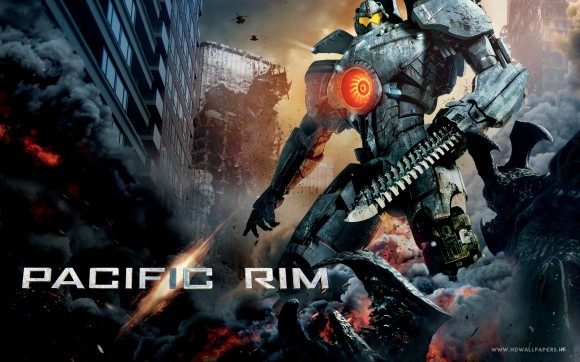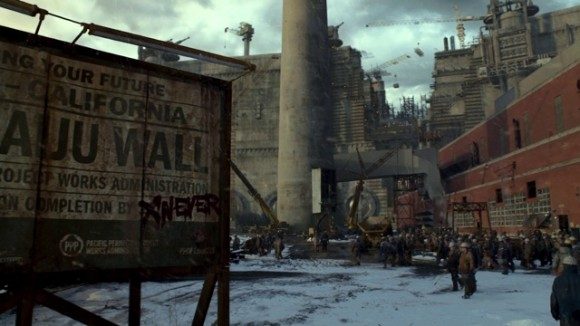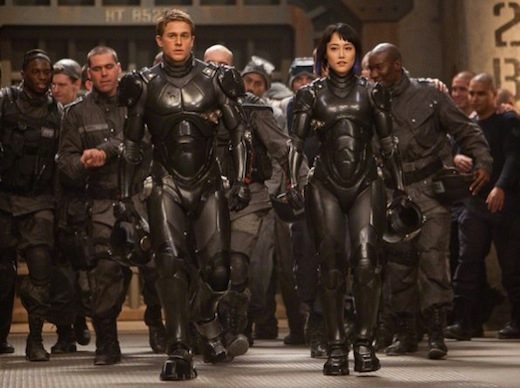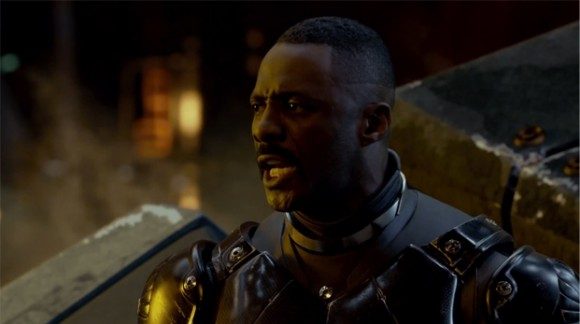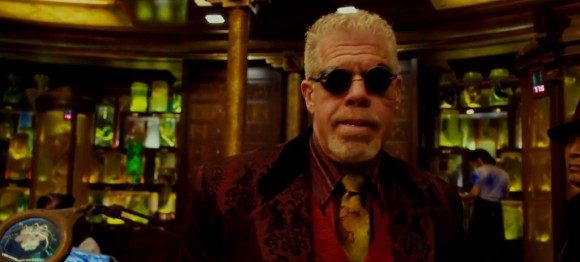Welcome to Revisionist history, where we, unencumbered by the demands of studios and profit margins, try to imagine different and better versions of the movies that are out there. This is not a review; it is a full-spoiler discussion of what works and what doesn’t, particularly from a story/concept standpoint (i.e. unless there’s a particular tic that is distracting, it’s hard to account for a poor acting performance or other failure in execution alone other than to say, “Do better.” Which isn’t very interesting or helpful to anyone.)
This week, we’re revising Racific Rim.
Well that was unexpected.
As I alluded to a couple weeks ago on the Weekly Trailer Roundup, I didn’t have high hopes for Pacific Rim. But, much like White House Down, I went to see it because I anticipated good fodder for discussion here and was pleasantly surprised by the result.
Not that we won’t have lots to talk about.
Without going into too review-ish territory (not the point of this column or this article), Pacific Rim strikes me as an excellent single-serving movie. It’s a very pretentious movie, but when combined with the oh-my-goodness-this-is-so-stupid-but-so-awesome factor, that pretension actually works in the film’s favor. It gives the illusion of depth in both plot and character that the film rushes you past fast enough that you can’t see the man behind the curtain. Or giant robot. Take your pick.
See, I think Pacific Rim works more out of clever manipulation than actually good storytelling. A fine line, to be sure, but let’s look at a few of the details, and I think my meaning will become more clear.
First, let’s give kudos where due. This is a hard premise to treat with the pseudo-seriousness that Pacific Rim manages to pull off, and the introductory sequence and voiceover have a lot to do with that. The film doesn’t coddle us or try to explain every detail. It very plainly lays out, “This is what we did, this is what worked,” and expects the audience to roll with it. In fact, this is imperative. It doesn’t give us time to think about the alternatives (several of which come to mind pretty quickly as more viable alternatives). So giant robots that must be piloted by two people who are inside the robot becomes a given. Wow. And what’s more – the film maintains this illusion throughout the movie. Did you notice how the audience never is given a pilot POV shot? Because as soon as we got that, we’d begin to wonder how they could effectively control their giant Iron Man with such a limited field of vision. We’d quit suspending our disbelief. But instead, we just see them inside, doing their piloting. They move, the robot moves. We buy it. Brilliant.
This is the essentially same trick the movie runs at us over and over again, with varying degrees of success. There are at least seven meaningful subplots to this film. That’s a pretty full movie. But each one is excusable, even desirable, because it adds to our understanding of both the world and its characters. It makes the near-future of Pacific Rim feel tangible. Lived in. People will always have personal relationships and personal goals, and in a world where the main characters’ memories are frequently connected in a very literal way, it makes sense that this would be all the more important a focus.
But notice also – how many of these sub-plots actually have some sense of conclusion? Take, for example, Raleigh Becket’s (Charlie Hunnam) initial hesitation at re-entering the Jaeger program due to supposed psychological trauma. It’s used to explain his five year absence while the Jaeger program has been gradually whittled down to a near halt, and give him (and us as the audience) fresh entry into a strange world. This is meaningful. We saw the scene of his brother being literally ripped away from him, and we can imagine the magnified psychological experience of having been mentally connected to him when that happened. We can see how this has shaped the last five years of his life. But once he rejoins Marshal Pentecost (Idris Elba), this is almost entirely left aside as we’re shuttled off to other plotlines. It gives a feeling of depth to the character that we hold onto without ever delivering on those depths. An illusion. We see it with Mako and her supposed historic difficulty managing her own memories (presumably the reason she’s initially disallowed from piloting Jaegers, but which she shakes off the moment they’re actually needed in battle). We even see it in elements of the premise.
Early on, we’re told that the world governments are abandoning the Jaeger program to concentrate resources on building a giant wall (probably a very thinly veiled commentary on off/on U.S. plans to build a wall along the entirety of the Mexican border). Sounds good, except we’re never given any reason to believe this is a good idea. We’ve already seen the destructive powers of the Kaiju, and our suspicions are promptly confirmed when we see one go busting through. Yet even after this point, the Jaeger program functions as this little nothing entity. We’re given to believe they’re the only saviors of humanity, yet they have no funding (relatively speaking) no team of scientists working around the clock on solutions to close or contain the portal (just a couple nutjobs), no indication that they’re anything more than an afterthought. It’s weird. But we’re never given any time to think about it. We’re told “this is the way it is” and whisked off before we can catch our breath to question. We have the impression that this is Han, Luke, Leia, and Chewie running through the corridors of the Death Star, when in reality it should be more like the whole Rebel Alliance analyzing the Death Star plans. And then maybe building their own.
So that’s the pattern of Pacific Rim. Now let’s see if we can’t correct a few of its more egregious problems to create a film that not only feels fully realized, but is.
We’ll open much the same way, with a quick and effective summation of what’s happened and where we are. The one exception: a little more sense of progression. We’ll reason that missiles endangered the very populations that they were trying to protect, and so Jaegers were invented. Honestly, it doesn’t really matter that much; unlike character holes, this basic tenant of the premise can be something we’re just told to accept, so long as the Jaegers themselves seem to make sense. On that note, they’re not going in so empty-handed this time. Guillermo Del Toro may have bee trying to avoid too many overt similarities to, say, Transformers, but there’s no excuse for hiding a sword until halfway through the movie. We’ll give the Kaiju better armored plating; they are, after all, the heirs to the dinosaurs. We’ll also tweak the history so the Jaeger program never got quite so cocky. Whether they were regularly beating the Kaiju or not, there was still an interdimensional rift on the ocean floor that wasn’t going away. People didn’t stop working on that problem.
So we’re given the whole spiel about drift-compatibility and two pilots, and we see Raleigh’s brother killed. Titles. Come in five years later, and we learn that with the gradual increase in the rapidity of Kaiju attacks, Jaegers are less and less prepared (and repaired) to meet them. It’s a war of attrition and humanity is losing. We also see Marshal Pentecost have a meeting with the world leaders (like before) who inform him that major resources are going to be diverted from the Jaeger program, something that apparently has been happening gradually for a while now. It seems there’s a plan to colonize Mars that is viable, and in case the Jaegers aren’t able to restrain the Kaiju, emergency launches are being prepared in secret.
The Marshal goes to recruit Raleigh like before, and we’re re-introduced to him, now working as a miner who delivers raw materials to a needy Jaeger program. He’s a hard worker, but much less outgoing this time, and favors his left arm. There may not be anything physically wrong with it, but it’s clear he’s got a mental block. Despite his protests, the Marshal brings him in. During the tour of the Jaeger facility, we see some of the vigor come back to Raleigh, but at the end he objects that even if he were ready to let someone in his head again, who could they find that’s drift-compatible? As we’ve seen to this point, most pilot pairs are familial relations. Drift compatibility is likened to blood type, except there are more variations.
The fight training exercise commences as before, except that it’s less refined and more brutish (where did he learn those fancy moves, after all? I thought he said at the top he and his brother had been brawlers) and it’s also not specifically to find a copilot (though that might be the Marshal’s ulterior motive). Raleigh looks very unpolished as he favors his left arm and leaves himself very open to attack. Frustrated, the Marshal sends Mako in to try to force him to open let loose. Their styles are polar opposite – she’s all technique with no fire, he’s all fire but lacking technique. She draws him out though, and when he finally starts fighting fully and tags her she roars back. Finally, we see a display. It’s also the first suggestion that Mako might make a good copilot – a notion that even she hadn’t entertained before then, both because of personal issues when drifting and the hard science issue of pilots needing to be inherently drift-compatible with one another.
Like the existing movie, Raleigh pushes Mako to be his co-pilot. However this time around, it’s she that’s rejecting the notion, although the Marshal is behind it as well. She eventually confides that she hasn’t ever drifted with anyone because she can’t control childhood trauma. Raleigh says he hasn’t drifted with anyone since his brother died. He admits that the very notion scares him to death. Mako suggests he use the simulators to get back into the hang of it, but Raleigh says they aren’t like the real thing. He finds out they’re the same drift-type and convinces her to try it with him. They sneak aboard the Gypsy Danger.
All they start up are the basic electronics, so no one knows they’re aboard. We start out more calmly, and see that Raleigh’s still shutting himself out a bit out of habit. It pushes Mako back into her own memories, and as we go into Mako’s memory sequence they accidentally mentally spin up the main drives to the Jaeger. Like before, they’re an instant from firing on the main facility when Raleigh finally drops down his barriers to their mental bond and is able to get Mako’s attention. He talks her down.
The Marshal is, of course, furious, and grounds them from combat. They do keep training in simulators, however, and we see them struggling to release their respective baggage and work together. During all this, we’re getting some amount of sub-plot, chiefly from the lead scientists, who, rather than work alone, lead teams. We still include Hannibal Chau (Ron Perlman), but rather than drifting with the Kaiju, the subplot focuses on the scientists wondering why their teams, so essential to shutting down the portal and/or preparing new weapons for the next Kaiju attack, are being depleted. Through Chau’s black market, one learns about the plans for Mars colonization, but convinces Chau, who has everything to gain by Earth remaining viable and his Kaiju stores becoming even more rare and valuable, to give him Kaiju remains to study (in this scenario, Chau probably doesn’t have the agreement with the Marshal, but there’s no accounting for human greed, right?) The scientists eventually discover structures in the Kaiju biology that aren’t in their little bug cleaners that line up with energy readings from the rift. Amidst plenty of bad blood with the government for wanting to secretly ship off a few choice colonists, they hypothesize that it will be possible to go through the rift as long as it is opened by Kaiju biological matter.
Raleigh and Mako are still grounded, but after a Kaiju event rapidly followed by a fast double event (no more of that EMP stuff, by the way, that made zero sense) leaves the Jaeger ranks decimated (and plans for evacuation are about to be put into action) a last-ditch effort is conceived that Raleigh and Mako will take part in. They are to be part of the diversion as several other Jaegers try to capture a Kaiju and force it back through the rift with a nuclear bomb. It’s harrowing, and as the Jaeger force falls apart to the Gypsy Danger is forced to try to carry the mission through. Mako is injured and Raleigh ejects her, taking control of the Jaeger himself, questionable left arm and all, and is forced to overcome once and for all the emotional baggage that’s held him back. He rides a Kaiju into the rift and detonates the Jaeger’s core. He dies a hero.
Which, of course, kills the protagonist for a potential sequel. But what about this: instead of giant mechanical fighting robots, the sequel is all about genetic engineering. That thing about the dinosaurs that’s dropped in was super interesting, not only for the clever explanation for the giant lizards, but also for the questions it raises about the origin of life on Earth. What will meddling with the DNA of Kaiju remains accidentally unleash?
And that’s our revision. We’re not changing a lot on the large scale, it’s more about focusing the elements that are already there and pulling out a couple that just get in the way. Suggesting character is one thing. Bringing that to bear in full sub-plot is quite another, and it cluttered Pacific Rim a little. Still, there’s more than one way to skin a cat (or a Kaiju). Have your own ideas about how Pacific Rim should have gone? Let us know in the comments!

